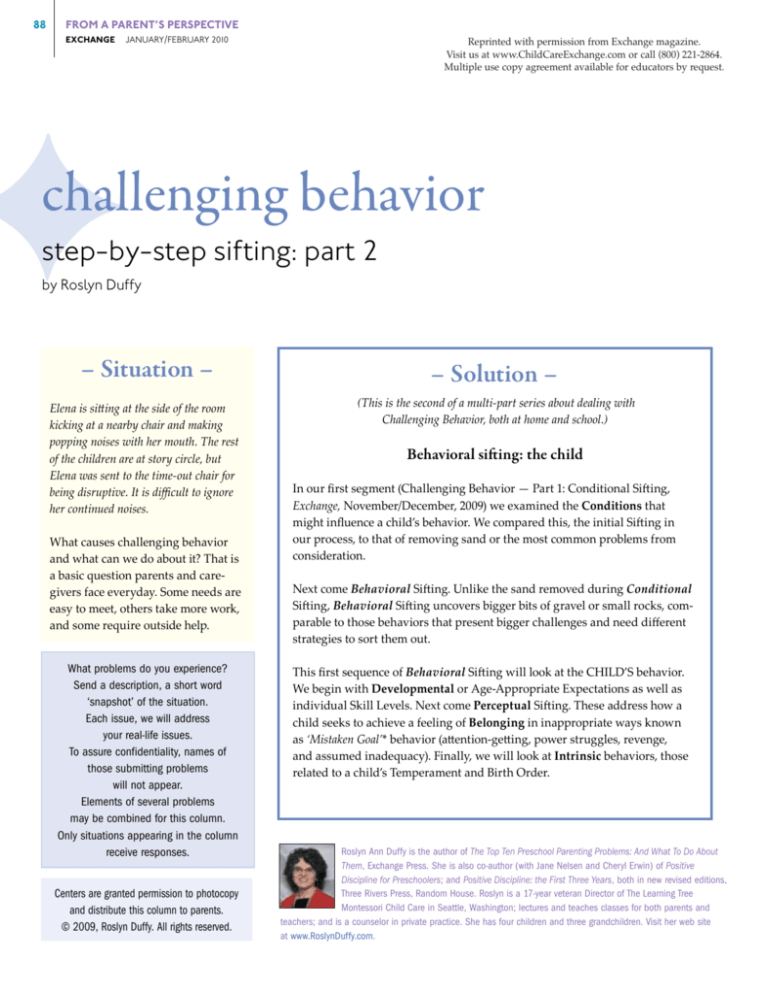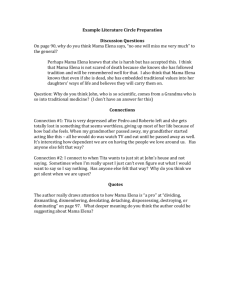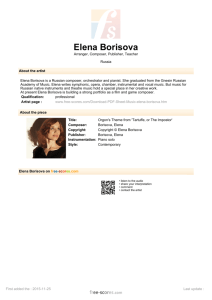
88
FROM A PARENT’S PERSPECTIVE
EXCHANGE
JANUARY/FEBRUARY 2010
Reprinted with permission from Exchange magazine.
Visit us at www.ChildCareExchange.com or call (800) 221-2864.
Multiple use copy agreement available for educators by request.
✦
challenging behavior
step-by-step sifting: part 2
by Roslyn Duffy
– Situation –
– Solution –
Elena is sitting at the side of the room
kicking at a nearby chair and making
popping noises with her mouth. The rest
of the children are at story circle, but
Elena was sent to the time-out chair for
being disruptive. It is difficult to ignore
her continued noises.
(This is the second of a multi-part series about dealing with
Challenging Behavior, both at home and school.)
What causes challenging behavior
and what can we do about it? That is
a basic question parents and caregivers face everyday. Some needs are
easy to meet, others take more work,
and some require outside help.
What problems do you experience?
Send a ­description, a short word
‘snapshot’ of the ­situation.
Each issue, we will address
your real-life issues.
To assure ­confidentiality, names of
those ­submitting ­problems
will not appear.
Elements of several ­problems
may be ­combined for this column.
Only ­situations appearing in the column
receive responses.
Centers are granted permission to photocopy
and distribute this ­column to parents.
© 2009, Roslyn Duffy. All rights reserved.
Behavioral sifting: the child
In our first segment (Challenging Behavior — Part 1: Conditional Sifting,
Exchange, November/December, 2009) we examined the Conditions that
might influence a child’s behavior. We compared this, the initial Sifting in
our process, to that of removing sand or the most common problems from
consideration.
Next come Behavioral Sifting. Unlike the sand removed during Conditional
Sifting, Behavioral Sifting uncovers bigger bits of gravel or small rocks, comparable to those behaviors that present bigger challenges and need different
strategies to sort them out.
This first sequence of Behavioral Sifting will look at the CHILD’S behavior.
We begin with Developmental or Age-Appropriate Expectations as well as
individual Skill Levels. Next come Perceptual Sifting. These address how a
child seeks to achieve a feeling of Belonging in inappropriate ways known
as ‘Mistaken Goal’* behavior (attention-getting, power struggles, revenge,
and ­assumed inadequacy). Finally, we will look at Intrinsic behaviors, those
related to a child’s Temperament and Birth Order.
Roslyn Ann Duffy is the author of The Top Ten Preschool Parenting Problems: And What To Do About
Them, Exchange Press. She is also co-author (with Jane Nelsen and Cheryl Erwin) of Positive
Discipline for Preschoolers; and Positive Discipline: the First Three Years, both in new revised editions,
Three Rivers Press, Random House. Roslyn is a 17-year veteran Director of The Learning Tree
Montessori Child Care in Seattle, Washington; lectures and teaches classes for both parents and
teachers; and is a counselor in private practice. She has four children and three grandchildren. Visit her web site
at www.RoslynDuffy.com.
We will use the same process as before:
• Discover: What is going on? Gather
­information.
• Decide: Why is this happening and what
can be changed?
• Do: What will I try? When? How?
• Refine: Did it work? If not, what next?
Either repeat this Sifting and try a different
response, or move to another level of Sifting.
Behavioral sifting: the child
Using the same example as in our first,
or Conditional Siftings, let’s assume that
Elena’s challenging behavior has continued. Our progression for Behavioral
sifting: the child, will be:
CHILD BEHAVIOR
Developmental Sifting
Age-Appropriate Expectations,
Skill Levels
Perceptual Sifting: Belonging
‘Mistaken Goal’ b
­ ehavior
(attention-getting, p
­ ower struggles,
revenge, ­assumed inadequacy)
Perceptual Sifting: Intrinsic
Temperament
Birth Order
Child behaviors
When concerned about challenging
behavior, of course we look to what it is
the child is doing or her behavior. In this
stage of the sifting process we’ll break
down the types of behavior we may be
seeing.
Developmental SIFTING
Development refers to what this child can
do. Do our Expectations match her Skill
Level? It may seem strange to add this as
a step in our process, but it is surprisingly easy to look at a child, large (or small)
for his age, and assume he has the skills
of an older (or younger) child. We know
to expect certain behaviors at different
ages (refer to Developmentally Appropriate Practice in Early Childhood Programs
Serving Children from Birth Through
Age 8, edited by Carol Copple and Sue
­Bredekamp, NAEYC, Third E
­ dition,
2009). Are our expectations in line with
this child’s development?
Let’s take a look.
• Discover: What is this child’s age? What
expectations are appropriate for a
child of this age?
• Decide: Are our expectations and this
child’s development in sync? Is this child
developmentally on target?
If Elena were a toddler, sitting with a
group or remaining in a designated place
during story circle may be beyond her capabilities. However, if Elena were five,
expecting such skills would be reasonable. What specific skills are lacking?
This process allows us to adjust expectations or to maintain appropriate
ones, but focus on skill training and
practice.
• Do: Choose a response in line with a
child’s development.
Making group time shorter might lead
to success for Elena, the toddler. At
age five, asking Elena to go over what
is expected before story circle begins
could help her to behave appropriately, because the expectations will
be fresh in her mind. For now, we’ll
assume Elena is five and her teacher
takes a moment to prepare for circle
time by asking Elena what she needs
to do during story circle:
‘Sit in my own space.’
‘Raise my hand before talking.’
‘Don’t make noises or poke others.’
FROM A PARENT'S PERSPECTIVE
JANUARY/FEBRUARY 2010
89
EXCHANGE
• Refine: Did it work? Great! If not, try
again with a different plan or proceed
to the next Sifting.
Perceptual SIFTING: Belonging
The term ‘Mistaken Goal’ is a Positive
Discipline* term used to identify four
basic ways in which children seek to
establish a sense of ‘belonging’, whether
at home, school, or elsewhere. The basic
premise is that all children (and adults)
want to feel a sense of belonging and
significance, but they (and we) often go
about doing so in ‘­mistaken’ ways. These
­t ypically include:
—Attention (I need to keep others
­focused on me)
—Power (I can prove that you can’t
make me)
—Revenge (I’m hurt, so I’ll hurt ­others
or their things)
—Assumed Inadequacy (I can’t do it
well enough — so don’t expect much
of me)
When identifying ‘Mistaken Goal’
­behaviors, it helps to look at a situation
from a child’s perspective.
• Discover: What does this child’s behavior
achieve? Are other ­children laughing
at her antics or is the teacher always
busy with her (­attention)? Is she defiantly doing/not doing something she
should/shouldn’t be (power)? Could
she be upset about something and
reacting with a hurtful response (revenge)? Does she feel unable to meet
expectations ­(assumed inadequacy)?
• Decide: There is little doubt that Elena’s
circle time behavior results in lots of attention, both from classmates and her teachers. Even though this attention may
be negative (being sent to time-out),
as far as a child is concerned, it is still
attention.
Another clue to a child’s ‘Mistaken
Goal’ is the adult’s emotional response.
Attention-getting behaviors tend to
90
FROM A PARENT’S PERSPECTIVE
EXCHANGE
JANUARY/FEBRUARY 2010
trigger annoyance and irritation
(whereas power struggles elicit feelings of being challenged; revengehurt, disbelieving; inadequacy
— helpless, hopeless). Since Elena’s
teacher feels annoyed more than anything else, we will focus on ‘attention’
as Elena’s probable ‘Mistaken Goal’.
Perhaps her teacher could designate
a place where Elena could look at
books if she chooses not to participate in group time or if her behavior
becomes disruptive. Elena and her
teacher would need to discuss and
agree upon such a plan, (before, not
during, a reoccurrence of Elena’s
misbehavior).
Please Note: This is a similar solution to the one chosen in a previous
Sifting (physical), but the focus this
time is on ‘Attention’ implications.
The important thing when sifting
out ‘Mistaken Goal’ behaviors is to
gain insight into how a child tries to
‘belong’ or establish her role in the
group (or family).
• Do: Once a place is designated for Elena
to go to when she is disruptive, getting
her there will need to happen with as little
attention as possible. Perhaps a signal
(the teacher wiggling her own earlobe) that would tell Elena it is time to
go to her book area. Or, a classroom
aide could gently lead Elena there,
without the group’s activity being
interrupted.
Instead of having Elena leave after
misbehaving, we might set increasing
goals for her participation. After five
or ten minutes, she can be excused
to her book area. These intervals can
be increased in increments, so that
Elena gets positive and appropriate
attention for her successes, instead of
attention only for misbehavior.
If none of this worked, we move to the
next Sifting.
PERCEPTUAL SIFTING: Intrinsic —
Temperament
Temperament is individual and uniquely
our own. From birth, temperament
predisposes us to certain tendencies,
such as activity level, adaptability, or
persistence.**
• Discover: What do we know about
this child? Is she shy, enthusiastic,
­predictable?
Let’s say we know that Elena is
new to this classroom and that her
previous teacher had noted, “it often
takes Elena quite a while to adjust
to even simple changes in classroom
routine.”
• Decide: It would be reasonable to
assume that Elena may have a slowto-warm-up Temperament. The appearance of her misbehavior after
being transferred to an unfamiliar
classroom could reflect discomfort
triggered by temperament.
TIP: It may take several tries for a new
plan to succeed. Behavior sometimes
worsens, at first, as children check to see
if we’ll maintain our new response or if
they can get us to ‘change back’ to our
more familiar reactions. (‘Change Back’*
behavior is explained in detail in
the chapter “Change,” The Top Ten
Preschool Parenting Problems, Duffy,
Exchange Press, 2008).
• Do: Instead of sending Elena away from
story circle, ask her if she might be more
comfortable watching from the sidelines.
Set up a chair where she can watch
what is going on. Offer to move the
chair closer every day, until she feels
ready to be a full participant.
• Refine: What happened? If it worked
— Congratulations! If not, Refine.
Perhaps Elena will need to transition from her observer’s chair to the
• Refine: What happened? If it worked
— Congratulations! If not, Refine.
teacher’s lap or to a seat next to an
aide. Slow down, and keep trying.
If none of this worked, we move to the
next Sifting.
PERCEPTUAL SIFTING: Intrinsic —
Birth Order
Each of us has a unique view of the
world based on Birth Order. Birth Order
is a bit like the view from different
­windows of the same house (or in this
case, one’s family position). We all see
things a bit differently, based on this
unique vantage point.
• Discover: Is Elena an only child? The
third or fourth in her family? Let’s say we
know that Elena is the youngest child
in a family of three girls. Youngest
children enjoy entertaining others.
• Decide: Do Elena’s classmates find her
disruptive behavior entertaining? Yes,
they do. How else might Elena entertain without being disruptive? Look
for ways to include her before she
becomes disruptive.
• Do: Her teacher asked Elena to demonstrate a dance at group time. Another day,
when the class read a story about ducks,
Elena imitated quacking, which the class
echoed. These opportunities achieve
Elena’s goal of entertaining, but in
­acceptable ways.
• Refine: What happened? If it worked —
Congratulations! If not, Refine.
Elena still needs to graduate to joining
in the group’s activities, but by leading activities her participation skills
will be improving, too. If none of this
worked, we move to the next Sifting.
Next time
If, after these siftings, the challenging behavior remains unchanged
or ­worsens, we need to proceed to
­Behavioral Sifting: Adult Behaviors.
FROM A PARENT'S PERSPECTIVE
JANUARY/FEBRUARY 2010
EXCHANGE
We will look at Adult Behaviors — Attitudinal Sifting: Generalized Expectations and
Interpersonal Sifting: Adult Discipline and
Skills or Adult Reactions, Consistency, and
Follow-Through.
To share your experiences with the
Sifting process go to:
www.RoslynDuffy.com.
**For a detailed look at the ‘Messages of
Misbehavior’ and ‘Birth Order’ (including explanatory charts), read ­Positive
Discipline for Preschoolers, Nelsen,
Erwin, & Duffy, 2007.
**Information on the ‘Nine Temperaments’ appears in both Positive Discipline: The First Three Years, Nelsen,
Erwin, & Duffy, Three Rivers Press,
Random House, 2007 and Positive
­Discipline for Preschoolers, Nelsen,
Erwin, & Duffy, Three Rivers Press,
Random House, 2007.
Download a blank template to
use in your own Sifting process
(for center or home use).
The articles in this multi-part
series on Challenging Behavior
will be offered at no charge for a
limited time.
Visit the Exchange web site:
www.childcareexchange.com/
catalog/
parenting_resources.php
While you’re there, check out
our vast selection of other
Parenting Resources.
The Top Ten Preschool Parenting Problems and
what to do about them! The title says it all: Here
you have the perfect way to put staff and
parents all on the same page — working
together in harmony on the most common
challenges of preschool parenting.
•whining
•notlistening
•tantrums
•manipulation
•mealtimeandbedtime
hassles
•siblingrivalry
•cleaningupmesses
•handwashingand
teethbrushing
•hitting,kicking,
pinching,andbiting
•pottytalkandname
calling
•plusmuchmore!
From long-time contributing
author to Exchange magazine
Roslyn Duffy
For bulk pricing, please contact Debbie Goodeve at
dgoodeve@ChildCareExchange.com or call (425) 836-9183.
For single copy sales, shop the online bookstore at
www.ChildCareExchange.com.
PO Box 3249, Redmond, WA 98073
Circle 93 on Product Inquiry Card
91







